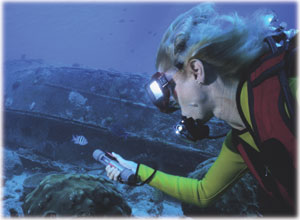|
Wisconsin
Shipwrecks: Finders Keepers?
The state owns the more than 700 shipwrecks in Wisconsin's territorial waters,
under the custody, control, and supervision of the Wisconsin Historical
Society. The law, with its hefty consequences, preserves the diving rights
for all users and prevents shipwrecks from being looted and damaged.
by Carlyle H. Whipple & Laura
Naus Whipple
  hen
we hear of sunken ships, our first mental images are usually of Spanish
galleons and treasure divers like Mel Fisher searching for years to find
a site that will yield millions of dollars worth of gold and jewels. Another
image is that of the Columbus-American Discovery Group, which in 1989
located, dove on, and recovered part of the cargo being transported in
1857 from Colon, Panama, to New York City aboard the side-wheel steamer
S.S. Central America. She sunk in a storm 100 miles off the Carolina coast
in waters at least a mile and a half deep. The official cargo consignment
in 1857 dollars consisted of $1,595,497.13 in gold bars, dust, and nuggets.
The 1989 value exceeded $1 billion.1
A third image, and closer to home, is the S.S. Edmund Fitzgerald that
sunk in Lake Superior on Nov. 10, 1975, coming to rest 550 feet below
the surface. Today, undersea technology permits the location and recovery
of almost anything lost on the sea floor, providing cost is no object.
Search and recovery expeditions can cost up to $50,000 a day depending
upon water depth and the type of equipment used. hen
we hear of sunken ships, our first mental images are usually of Spanish
galleons and treasure divers like Mel Fisher searching for years to find
a site that will yield millions of dollars worth of gold and jewels. Another
image is that of the Columbus-American Discovery Group, which in 1989
located, dove on, and recovered part of the cargo being transported in
1857 from Colon, Panama, to New York City aboard the side-wheel steamer
S.S. Central America. She sunk in a storm 100 miles off the Carolina coast
in waters at least a mile and a half deep. The official cargo consignment
in 1857 dollars consisted of $1,595,497.13 in gold bars, dust, and nuggets.
The 1989 value exceeded $1 billion.1
A third image, and closer to home, is the S.S. Edmund Fitzgerald that
sunk in Lake Superior on Nov. 10, 1975, coming to rest 550 feet below
the surface. Today, undersea technology permits the location and recovery
of almost anything lost on the sea floor, providing cost is no object.
Search and recovery expeditions can cost up to $50,000 a day depending
upon water depth and the type of equipment used.
Wisconsin, while lacking the high-profile
treasure shipwrecks of the oceans, has more than 700 shipwrecks within
its territorial waters. Beneath the waters of Lakes Michigan and Superior,
the Mississippi River, and the state's inland lakes and rivers can be
found an underwater museum of our state's prehistory and history. From
fur trade goods lost from overturned Voyageur canoes to the remains of
schooners and steamers, the exploration of Wisconsin's waters provides
many unique views into the state's past. It is no coincidence that our
state flag shows a sailor and anchor standing next to a farmer and his
plow: Wisconsin's lakes and rivers were an integral part of the lives
of native Americans, and they allowed European exploration,
expansion, and settlement of this state.
Wisconsin Owns the Shipwrecks
Lying Under its Territorial Waters
There are two converging lines of authority for the fact that the State
of Wisconsin owns all of the 700 shipwrecks and their related artifacts
that lie submerged under its territorial waters. The first line flows
from the Northwest Ordinance of 1787 and the Public Trust Doctrine, and
the second from the Abandoned Shipwreck Act of 1987. More than 200 years
of judicial precedent establishes the rule that these 700 shipwrecks belong
to the state under the custody, control, and supervision of the Wisconsin
Historical Society (WHS).2
Northwest Ordinance of 1787
At the conclusion of the American Revolution, Great Britain ceded to
the United States all lands north of the Ohio River, south of the centerline
of each of the Great Lakes, and east of the Mississippi River, known then
as the Northwest Territory. Congress enacted the Northwest Ordinance of
1787 (NWO) to administer the lands preparatory to statehood. Title to
submerged lands was given to the states that would be formed in the Northwest
Territory as each was admitted to the Union.3
"The sovereignty and jurisdiction of (Wisconsin) extend(s) to
all places within the boundaries declared in Article II of the Constitution,
subject only to such rights of jurisdiction as have been or shall be acquired
by the United States over these places."4
Article 2, Section 1 of the Wisconsin Constitution was accepted by Congress
upon the state's admission to the Union and is in conformity with the
original territorial grant of Articles IV and V of the NWO.
Upon its admission to the Union in 1848, Wisconsin became the
owner of all submerged lands within its boundaries, including the bottoms
of rivers, inland lakes, and Lakes Michigan and Superior. "Submerged lands"
are the bottoms of all navigable waters lying below the ordinary high
water mark.5
The ordinary high water mark for each of the Great Lakes was last established
by the International Great Lakes Datum Commission in 1955 at 601.5 feet
above sea level for Lake Superior and 579.8 feet above sea level for Lake
Michigan. The Great Lakes are factually and legally inland seas and subject
to federal admiralty law and jurisdiction.6
Page
2: Public Trust Doctrine 
|
